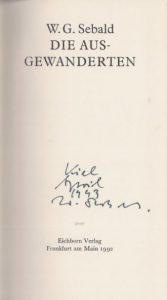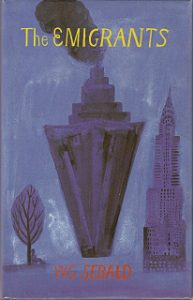Is it fiction? Is it documentary literature? It’s a little bit of both and the impression of something hybrid is even strengthened by the many black-and-white photos that are inserted into the text without explanation or description. W.G. Sebald’s book “The Emigrants” (“Die Ausgewanderten”) is maybe the masterpiece of this author who came to England in 1966 and who spent the rest of his life as a lecturer and professor teaching at universities in England. His career as a prose writer (in his native German language) started when he was already in his mid-forties.
“The Emigrants” is a collection of four long stories. Dr. Henry Selwyn, born as Hersch Seweryn in a shtetl near Grodno in Lithuania has come to England as a child and has against all odds made a career as a surgeon. The narrator, whose living conditions, opinions and favorite books coincide with W.G. Sebald’s gets to know Dr. Selwyn as a retired doctor leading a secluded life mainly in his garden when he is renting a flat in Dr. Selwyn’s house. A distanced friendship between the author and Dr. S. is developing and finally the doctor is telling the author the story of his life. The marriage of S. with a girl from Switzerland where he studied is not happy, maybe because S. kept his Jewish origin too long hidden from her, maybe because they just lost the love that was between them in the beginning. The happiest period of his life was according to S. his study times in Switzerland, when he used to go hiking with an old Swiss alpinist (who disappeared in the mountains one day). S. seems to be strangely detached from life, melancholic and living for his memories.
After a return from a visit in France, the narrator receives the message of the suicide of S. Years later, during a sojourn in Switzerland, a local newspaper reports that the body of an alpinist was found that was missing since more than 70 years. It turns out to be the missing hiking partner of Dr. S.
“And so they are ever returning to us, the dead. At times they come back from the ice more than seven decades later and are found at the edge of the moraine, a few polished bones and a pair of hobnailed boots.”
The story “Unexpected Reunion” (Unverhofftes Wiedersehen) by Johann Peter Hebel comes to mind, an author with whom Sebald was familiar since early childhood because his maternal grandfather introduced him to this Alemannic writer.
Hebel plays also a role in the second story that was inspired by one of Sebald’s school teachers. In the story his name is Paul Bereyter, a “born” teacher who was able to turn every school lesson into something interesting and who was known for his unconventional but very inspiring way to teach. The narrator mentions for example that he introduced Hebel’s “Calendar Stories” to the pupils instead of the textbook lessons that he seemed not to consider as worthwhile for the children.
Bereyter knew already in his youth that he wanted to become a teacher and nothing else and he succeeded to achieve his aim in the 1930s. But as a “quarter-Jew” (one grandfather was Jewish) he lost his position during the Nazi era. After the war (which he survived as a soldier) he was re–installed as a schoolteacher, but something had changed within Paul, as everyone called him.
“The seasons and the years came and went…and always…one was, as the crow flies, about 2,000 km away – but from where? – and day by day, hour by hour, with every beat of the pulse, one lost more and more of one’s qualities, became less comprehensible to oneself, increasingly abstract.”
In his later years, Paul is haunted by memories. After his early retirement he is spending more and more time in France (where he lived for a few years as private teacher in the 1930s). There he makes friends with a Mme Landau who shares his interest in literature (Paul is approaching her after he sees her reading a Nabokov biography). From Mme Landau the narrator receives more information about the later years of Paul – also he was an emigrant, haunted by the ghosts of his past and by the fact that nobody in his small home town pretended that something had happened to the “disappeared” Jews even decades after the war was over.
Also the last two stories seem to be based on the lives of real persons. One is the story of a granduncle of Sebald who emigrated to America and who became a butler in a rich Jewish family. With the son of the family he traveled around the world shortly before WWI and they have obviously had a homosexual relationship. After the outbreak of a mental illness and the early death of his friend, the author’s granduncle devotes his life to the family of his friend until in his last years he is retiring to a mental hospital (without actually being ill in the classical sense – Robert Walser comes to mind), even wishing to be completely annihilated by an extreme form of electroshock therapy that was en vogue in the 1950s.
The last story, about the German-British painter Max Ferber (inspired by Frank Auerbach, whom Sebald met when he was a young student in Manchester – in the first German edition the name of the character was Max Aurach), doesn’t end with the death of the protagonist but since Ferber who came to England without his parents (who were killed in the Concentration Camps in the east) gives the narrator a diary of Ferber’s mother which she kept until her marriage, the narrator decides to undertake a study tour to Bad Kissingen, the home town of Ferber’s mother, which is not really a homecoming but a very disturbing experience.
In the meantime, Max Ferber has made a name of himself in the art world, but he almost never leaves his studio in a dilapidated area of Manchester. Only once he goes on a visit to Colmar to see the Isenheim Altarpiece by Matthias Grünewald. The work of this strange man proves to be the intuition of the extreme power of pain in Ferber’s oeuvre.
Beside the already mentioned literary influences, the reader has also to think of Thomas Bernhard (especially when Sebald is describing his visit in Bad Kissingen in the last story), but also of Georges Perec and of Vladimir Nabokov.
The passionate butterfly collector Nabokov is making an appearance in all four stories (in the last one even twice), and here Sebald is in my opinion doing a little bit too much. This “running gag” is not necessary for the dramaturgy of the stories and a bit of a cheap effect. But this is a minor flaw in this extraordinary collection of stories that has great qualities. Sebald is an excellent prose writer that is clearly inspired by Stifter or Gottfried Keller. The hybrid mixture of documentation, diary, photo novel and story seems to be the appropriate form to speak about the fate of these “emigrants” (Goethe’s “Unterhaltungen deutscher Ausgewanderten” echoes also in the title of the book). And indirectly the book is also a book about the friendship of Sebald with his maternal grandfather because in all four stories a friendship between a young and a much older man plays an important role (Sebald’s relation to his father seems to have been strained in the contrary).
The book received very high praise by literary critics and was also a big success on the German and international (especially English-speaking) bookmarket. Susan Sontag, Antonia Byatt, Michael Ondaatje or Salman Rushdie considered Sebald as one of the most important authors of our times.
Very few critics, like the German novelist Georg Klein have voiced their reservations about Sebald’s books. Klein was speaking about Sebald’s “sweet melancholic masochism towards the past”, which claims a “false intimacy with the dead”. Sebald also seems not to have noticed the changes in Germany following 1968 (he visited the country very rarely after 1966) which made some of his statements regarding his home country a bit out of time and place and for my taste sometimes a bit too self-righteous.
But be this as it may, Sebald was a very important and excellent writer and “The Emigrants” is definitely one of the great books about the historical and personal disasters of the 20th century and therefore I recommend it very strongly.
W.G. Sebald: The Emigrants, Harvill 1996 (transl. by Michael Hulse); Die Ausgewanderten, Eichborn 1993
A very interesting essay about Sebald’s biographical sources of his work by the American germanist Mark M. Anderson sheds additional light on “The Emigrants” and other works of Sebald: http://www.wgsebald.de/vaeter.html
Other Reviews:
Tony’s Reading List
© Thomas Hübner and mytwostotinki.com, 2014. Unauthorized use and/or duplication of this material without expresseded and written permission from this blog’s author and/or owner is strictly prohibited. Excerpts and links may be used, provided that full and clear credit is given to Thomas Hübner and mytwostotinki.com with appropriate and specific direction to the original content.





 Facebook
Facebook RSS
RSS Twitter
Twitter